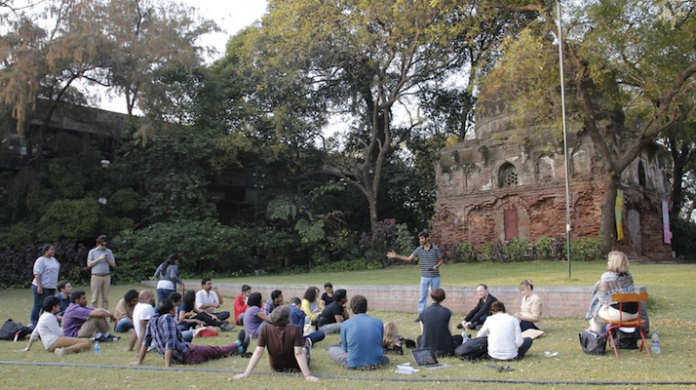A trip to India made Ben Eaton look at his own work in a new light and start to think seriously about the future
Future thinking
The national institute for design is in Ahmedabad, a city in the Gujarat region of India. As cities go, on the surface it isn’t particularly remarkable. This isn’t a particularly unfair assessment; it rarely sees any tourists and doesn’t have many monuments like some of the country’s other great cities. But it is my first experience of India and, like all cities, the more you unpeel it the more you discover. I have just returned from a two-week-long "lab" as a fellow of UnboxFestival, an international festival of design that takes place in Delhi. I, alongside 34 other creatives and academics from both England and India, spent a full-on two weeks working on the concept of Future Cities, an open and challenging brief delivered against the backdrop of Ahmedabad’s growing and sprawling city, with its politics of contested slum spaces, resettlements and new developments.
"...like all cities, the more you unpeel it the more you discover..."
A lot of our work as Invisible Flock stems from cities, or if not cities specifically then the environment by which we are surrounded, whether that be the sea or inner city Coventry, or Yorkshire where we are based. We began the company with the express intention of working in a cross-disciplinary manner, to work across sectors and genres, working equally with theatres, galleries, councils and music festivals. Unbox has been a timely reminder of that for me. In a context that focuses primarily on design, as a practice, a way of thinking and an aesthetic, the Unbox Labs have allowed me to re-contextualise a lot of our work as a company as well as my own practice, and to explore our own work through a slightly different lens.
Bring the Happy, our largest project to date and the one that was featured in last year’s British Council Edinburgh Showcase, is a work that is entirely built by the people of the cities it visits, made up of the happy memories they donate to us put onto giant maps. It is a project that looks back and asks people to conjure up memories, but recently we have been using it to look forward, to think of the landscape it creates as an imagined architecture built on emotion and empathy, to try and find a way for the memories we collect to speak to our future and a use them to conceive of what our cities might become.
"We began the company with the express intention of working in a cross-disciplinary manner, to work across sectors and genres, working equally with theatres, galleries, councils and music festivals."
It turns out that this is bang on the money of contemporary architectural critical practice in places like India. Architecture professors and town planners talked to us with great beauty about how cities should develop, and how you can create a shared vision of a city that is something other than stainless steel and glass and slums swept under the carpet. How can people living in slums be allowed to iterate, to maintain their culture and still be part of a city’s growth and story? All of this became wrapped up in all of the conversations that were held over the weeks, and in it I found echoes of Stockton, of Leeds, of all of the places that we had been to date with Bring the Happy.
And it made me wonder what does Bring the Happy India look like? How do the cities and their stories flow through our maps? In the UK, the relatively similar structure of our different cities means the stories we are given tend to cluster and appear in clumps: city centres, residential areas, parks and hospitals, you can make them out based on the patterns that the memories make on the maps alone. But looking at it through Ahmedabad, which sprawls and blurs in an organic and chaotic way, I wanted to try and imagine how the memories would appear, what would they be and what would they tell us about this place I only began to scratch the surface of during my visit.
"In Ahmedabad I found echoes of Stockton, of Leeds, of all of the places that we had been to date..."
Ultimately, an intense two weeks led to a series of projects and collaborations with the Indian and other UK creatives, all imagining what the future of our cities might be. Some built things, others took stuff out onto the streets. We, in a small group, imagined far futures, worlds where antibiotics no longer work (although this one is potentially not that far away), where new cities emerge around data hubs like they used to emerge around rivers and natural resources, and where only land that has been untouched because of natural disasters like Chernobyl remains as our natural reserves. We imagined how we would live in these worlds, how would we interact as humans. We built artefacts, imagined designs and thought about how we as humans will live in these places as a society. Hopefully these projects will have a future life.
As makers of interactive work, that is about how we participate in the world around us. Transferring our process and work to a context such as Ahmedabad forced is to consider its applications back home. It can’t but change your approach to what you do, recontextualising some of those core mechanics and ideas central to our practice.
Ben Eaton is an interactive and digital artist, and a member of Invisible Flock, a Leeds-based interactive art organisation. His two-week trip to India was supported by the British Council.
